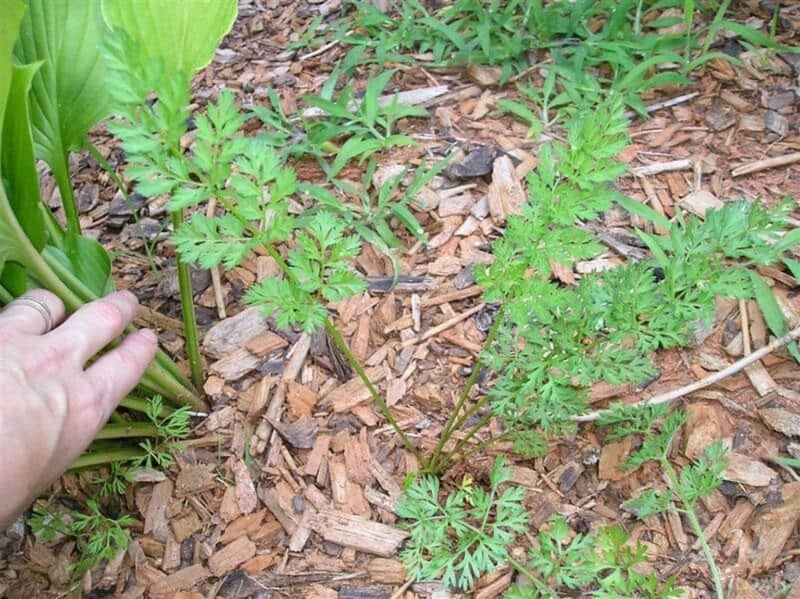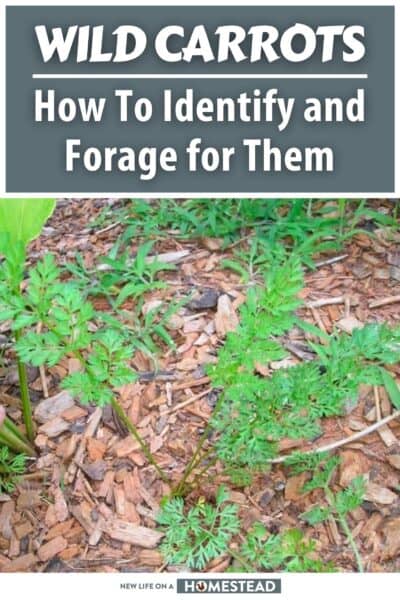The wild carrot, also known as Queen Anne’s Lace or by its scientific name Daucus carota, is one of the tastiest and most common wild edibles around.

Aside from the pale color and smaller size of the roots, they look and taste pretty much identical to the domestic kind you grow yourself or get at the grocery.
Accordingly, they are one of the most popular foraged veggies.
The bad news is that wild carrots have many imposters, and quite a few highly dangerous ones.
The king of them all, though, is the deadly poison hemlock! It’s scary how similar these plants look, and a single, innocent mistake when hunting for wild carrots might send you to an early grave.
To help keep you on the mortal coil, I am bringing you a guide with all of the info you need to positively identify wild carrots. That way you can breathe, and eat, a little easier!
Grab your spade and let’s get going.
Table of Contents:
Warning: Wild Carrots Look Very Similar to Deadly Hemlock!
It’s crucially important that you know that wild carrots, also known as Queen Anne’s Lace, bear a marked resemblance to the deadly poison hemlock and other carrot lookalikes.
This likeness can lead to an ultimately tragic and fatal case of mistaken identity…
Poison hemlock, scientifically known as Conium maculatum, is genuinely a lethal plant: Every part of it carries potent toxins, including the seeds, roots, stems, leaves, and fruit.
These toxins are compounds like coniine and gamma-coniceine, neurotoxins that can disrupt the nerve impulses to your muscles- even involuntary, automatic ones like breathing.
Ingestion can lead to the rapid onset of symptoms like trembling and convulsions, pain in the gut, weakness, heart arrhythmia, coma and death, usually from respiratory failure.
Consequences of the aftermath, assuming you survive, include muscle damage, kidney failure and sometimes brain damage from a lack of oxygen.
Assuming the victim can be kept alive on life support, survival prospects are pretty good with supporting care.
A surprisingly small dose of poison hemlock can be fatal: consumption of just a handful of leaves can potentially kill an adult, and much less will kill someone who is very young or old, or already sick. The seeds are far, far deadlier still!
When in doubt about any wild plant, you must always err on the side of caution! If you’re not absolutely positive of the plant’s identity, don’t risk it.
Where Can Wild Carrot Be Found?
You can find wild carrots in various parts of the world. They’re native to Europe and Southwest Asia but have now spread to North America, Australia, and New Zealand.
The plant readily naturalizes, and that means that anywhere it gets a toll hold it is likely to start spreading through the ecosystem.
Luckily, compared to many harmful, destructive or obnoxious invasive species wild carrot doesn’t seem to cause too many problems, though it’s not out of the question it might outcompete certain indigenous plants.
In the United States, wild carrot is found all over the country from coast to coast, although it is especially common west of the Mississippi River from Texas to and up the West Coast. It’s also quite prevalent in the south.
In parts of Georgia and much of Texas, you can see wild carrot growing freely in traffic islands and along roadsides all over the place, and its distinctive and easily noticed flowers can lead you right to it during the blooming season.
Where Does Wild Carrot Typically Grow?
Wild carrot prefers full sunlight and well-drained soil. It typically grows in meadows, pastures, and open woodlands, you’ll often spot them in fields, along roadsides, and in other disturbed areas where they can freely grow.
In ideal conditions you’ll sometimes find huge patches growing in thinner forests. Wild carrots can also grow in sandy or gravelly soils.
This is a biennial plant, which means it completes its life cycle over two years: In the first year, it forms a rosette (circular structure) of leaves and a taproot (the part that looks, smells and tastes like a carrot).
In the second year, it sends up the stalk which will later bear flowers.
Wild carrots are surprisingly adaptable and resilient, and this has allowed them to thrive in many different climates and conditions.
Accordingly, you can reasonably expect to find them anywhere so long as temperatures aren’t too extreme and they get enough sunlight.
The trouble is, if you’re looking to find wild carrots, you have a great chance of finding poison hemlock also, which grows in many of the same places and even, most worryingly, side by side!
| Latin name | Daucus carota |
| Life Cycle | Biennial or short-lived perennial |
| Emergence | germinates from 1/4-inch of soil depth |
| Reproduction | Reproduces by seed. One plant can produce between 1,000 to 40,000 seeds |
| Soil | well-drained to dry soils |
Identifying Wild Carrot, Step by Step
Height
Wild carrots are small to modestly-sized plants. They are low-growing, rarely taller than 3 feet.
When young, this short stature can make them easy to overlook, but their unique characteristics will present early in life which can help you with identification.
Note now that poison hemlock can grow much taller, often reaching heights of 8 or even 10 feet.
But while both plants are younger, or when poison hemlock is just getting established, it’s still easy to mix them up! Be mindful of this potentially lethal mistake.
Growth Pattern
Wild carrots have a distinctive growth pattern you can learn to recognize easily: They sprout very low to the ground from a central rosette, giving them a dense and clustered appearance close to the surface at all times.
This growth pattern is quite different from that of poison hemlock, botanically, which tends to grow much more vertically and less densely.
Leaves
The leaves of wild carrots are deeply lobed, fringed, and wispy, making them quite distinctive once you have up-close experience with them.
They look, as you would imagine, quite similar to the carrot tops you would see in the grocery store, though not identical. The leaves have a matte or satiny finish, and aren’t particularly glossy.
Be cautious if ID’ing on leaves alone: the leaves of hemlock and wild carrot are distinctive when mature, but young wild carrot leaves can look dangerously similar to poison hemlock!
The latter’s leaves are finely divided and lacy, somewhat like a carrot’s, but they are larger and have a glossier texture. Be vigilant and use multiple identifiers to distinguish them…
Stem
As you examine wild carrots, you’ll find that the stem is a prime way to identify them. The stems are hairy, have an even green color, and are smoother and thinner overall compared to many other wild plants.
It is a little silly, but one way to help you distinguish wild carrot from other plants is to remember the ditty “Queen Anne has hairy legs!”
That’s because wild carrot is also known as Queen Anne’s Lace. Get it? I hope our UK readers will forgive us, but it is helpful…
But contrast the stems of wild carrot with the stems of the deadly poison hemlock. Hemlock is smooth, hollow, completely hairless and often but not always marked with purple blotches and streaks.
Young stems might be solid green, and the color intensifies when the plant is close to dying back. This difference can be a lifesaver when distinguishing between the two!
Flowers
The flowers of wild carrots are small and white, growing in flat-topped, level, inverted-umbrella groups known as umbels. They are tiny, bright white and arranged in a radial pattern, each with five delicate petals.
Most notably, each umbel usually has a single dark reddish or brown spot in the middle; a feature unique to wild carrots that scientists believe helps attract certain insects and repel others.
This inconspicuous spot is another way to positively ID wild carrot, so you should keep it in mind when the blooms are present. See the next section.
Poison hemlock also produces white flowers in umbels, but they always lack the characteristic dark spots in the middle like those of the wild carrot.
The distinction might seem minor, but it’s a crucial one when differentiating between these two plants using the blooms.
They also grow in a more dome-like shape, and tend to be more scattered and less dense overall, though this takes an expert eye to determine by density alone.
Blooming Season
Wild carrots bloom during the summer months, typically from late May or early June through August or September, respectively. This is when they display their distinctive white flowers, making them much easier to spot.
This is also the blooming season for poison hemlock, though it’s usually over by late July or early August. This and the other similarities during their blooming season can easily deceive you.
What Does Wild Carrot Look Like When it Dies?
When the life cycle of the wild carrot comes to an end, it undergoes a truly fascinating transformation. Its flowers curl sharply inward, creating a highly distinctive and rigid “bird’s nest” shape.
The dried umbel can then detach, forming a tumbleweed. This unique feature makes the plant instantly recognizable even in its dying stages.
If you see tiny, cupped tumbleweeds on or near the plant, you know you’re dealing with wild carrot.
Poison hemlock, though it doesn’t form a similar bird’s nest is still just as deadly when it is dying or dead, so do not let your “confirmation” overtake caution when digging up a dead wild carrot to harvest the root.
Trust Your Nose
It turns out that your nose can be one of your best tools when identifying wild carrots. The roots, and to a lesser extent, the leaves both have that distinctive carrot smell we all know, while the rest of the plant exudes a pleasant, clean, grass-like aroma.
And it is this characteristic which will usually tell the tale between wild carrot and its insidious imposters, especially hemlock.
In stark contrast to the sweet carrot, poison hemlock emits an unpleasant, musty odor that many describe as akin to a mouse infestation.
Therefore, your sense of smell can provide life-saving clue when distinguishing between these two plants.
Carefully crushing a leaf or breaking a stem from either can easily tell you what you need to know.
But be warned, reader: the toxins of hemlock can be absorbed right through your skin, or even inhaled in some cases!
Always waft the aroma toward you, don’t put it right under your nose, and be sure to protect your hands.

Tom has lived and worked on farms and homesteads from the Carolinas to Kentucky and beyond. He is passionate about helping people prepare for tough times by embracing lifestyles of self-sufficiency.
